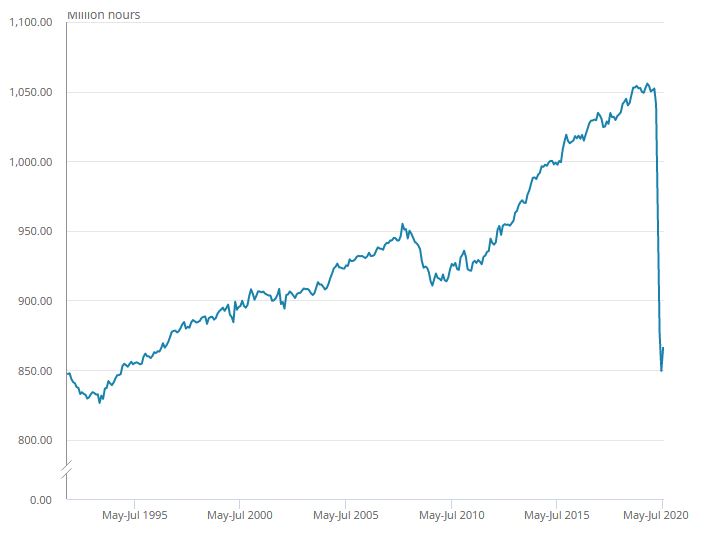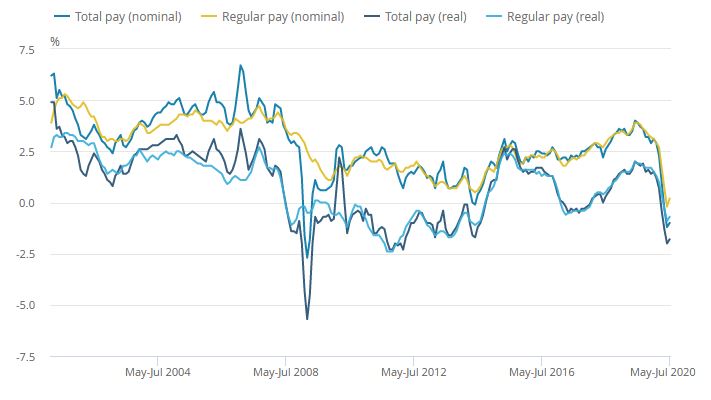ONS Labour Market September 2020
The latest ONS labour market data shows a drop in the number of PAYE employees as the furlough scheme begins to unwind, with an increase in unemployment disproportionately hitting young people
695,000 fewer on PAYE
- The number of paid employees was down by some 695,000, or 2.4%, in August compared with March 2020 according to flash estimates using PAYE data – around 36,000 lower than in July.
- Total hours worked remained low, but showed some signs of recovery in the three months to July 2020 as lockdown measures eased. Total weekly hours worked decreased by 183.8 million to 866.0 million hours in the three months to July 2020 compared to a year earlier.
- Accommodation and food services continued to be the hardest hit sector, with average weekly hours down 15.4 hours to 13.5 hours per week compared to last year. This compares to a record low of 13.0 hours a week reported in the previous month.
UK total actual weekly hours worked (people aged 16 years and over), seasonally adjusted, between March to May 1992 and May to July 2020

Source: ONS
Hiring up from a low point
- The number of job vacancies continued to recover in the three months to August, with vacancies almost 30% higher than the record low in April to June 2020 driven by small businesses looking to hire as the economy gradually relaxed lockdown measures.
- However, there were ultimately some 383,000 fewer vacancies than a year earlier and 48,000 fewer than the previous quarter.
Young people hit by unemployment
- There was little change in the employment rate at 76.5% in the three months to July, which was 0.1% points up on the quarter, but 0.4% points higher than a year earlier. This equates to 32.98 million people aged 16 years and over in employment, which is 202,000 more than a year earlier.
- Breaking the figures down shows disparity by age, with an increase in employment among those aged 25 to 64 years old. Within that age group, there was an increase of 236,000 on the quarter to 28.07 million, with a record increase of 67,000 for women in the 25 to 34 years age group.
- However, those aged 16 to 24 years saw employment decrease by 156,000 to 3.63 million, with a record decrease of 146,000 for those aged 18 to 24 years.
- Experimental data shows that more than five million people — including furloughed workers — were temporarily away from work in July, half of which had been away for more than three months.
- The unemployment rate in the quarter to July was 4.1%. This is 0.3% points higher than a year earlier and 0.2% points higher than the previous quarter.
- The youngest have been most impacted by unemployment. The number of people unemployed aged 16 to 24 years increased by 76,000 on the last year to 563,000, while other age groups saw falls or little change.
- The ONS’s experimental claimant count data shows the Claimant Count increased by 73,700 (2.8%) to 2.7 million between July 2020 and August 2020. Since March, the claimant count has increased by 120.8%, or 1.5 million.
- Meanwhile, redundancies increased by 58,000 on the year and 48,000 on the quarter to 156,000, marking the largest increases seen since 2009.
Real pay continues to decline
- Annual pay growth on a total basis remained negative in the three months to July, as bonuses fell by an average of 21.4% in the period.
For the three months to July:
- total pay (including bonuses) fell by 1.0%
- regular pay (excluding bonuses) increased by 0.2%
Adjusted for inflation:
- total real pay fell by 1.8%
- regular real pay fell by 0.7%
Great Britain average weekly earnings annual growth rates, seasonally adjusted, January to March 2001 to May to July 2020

Source: ONS
For July in nominal terms (that is, not adjusted for price inflation):
- average regular pay (excluding bonuses) for employees in Great Britain was £512 per week before tax and other deductions from pay – down from £507 per week a year earlier
- average total pay (including bonuses) for employees in Great Britain was £539 per week before tax and other deductions from pay – level with a year earlier
Back to Retail Economic News